By Maya Hilty of Carleton College
Hello from Cochrane, our beloved base camp for this semester! Over the past week, we completed our last research excursion surveying the population of huemul in Tamango Reserve. Tamango is a protected area only a few kilometers north of Cochrane (See Fig 1). Huemul (“whey-mool”) deer are a species of deer that is endemic to Chile, well-loved by Chileans, beautiful, curious, and currently endangered (See Fig 2).


The short and fast facts of our research were: both Team Coigüe (“coy-gwhey”) and Team Ñirre (“n-year-eh”) spent 4-5 days working with local park rangers to conduct a census of huemul. We already knew that the population of huemul in Tamango is small; population surveys have been performed by CONAF guardaparques (Chilean park rangers) on-and-off for 35 years, and the census data shows a steep decline in the population after 2004. Before then, some fifty huemul might be sighted in the park, but last austral fall, RRCS students and CONAF guardaparques only sighted 13 individuals. This time, we sighted 12.
The census was organized into four days of sweeping different areas of Tamango where the guardaparques have already observed huemul presence. These sweeps meant dividing ourselves into 10+ small groups of one guardaparque with a pair of RRCS students or instructors and then spreading out in these small groups along one side of the area we wanted to survey. Once approximately in position, all groups would hike in the same direction along the length of the area, about as far as we could reasonably manage in one day. Usually the terrain was pretty mountainous, and either forested or very scrubby, so groups were far enough apart that we couldn’t see each other, but the goal was to sight any huemul present.
Although seeing huemul was always a highlight of our days on this trip, I mostly felt lucky to be able to do applicable research while hiking around doing what any of us would do for the fun of it. On our first day of research, Adrienne and I paired up with Carlos, a good friend of the park rangers who works as a guide for camping trips in the area. As soon as we got out of the van in the morning, Carlos led us, chitter-chattering the whole way, straight up the mountainside from the road. Thankfully, his Spanish was easier for us to understand than that of other Chileans we’ve met, and he told us about everything from rugby to local perceptions of camping as we side-hilled the mountain, dropping through stands of trees and re-routing over cliffs (See Fig 3).
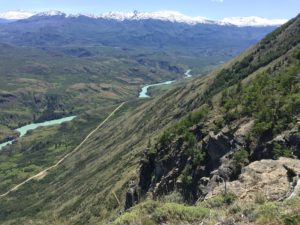
Occasionally we’d have to cross short sections of ravines thick with thorny scrub that grew above our heads, and it was a hoot watching Adrienne completely disappear into bushes as we tried to follow Carlos, who was sometimes hacking at the plants with a machete to try to cut a path for us (See Fig 4). That day was also our first day in Chile that really started to feel like summer, and all of the wildflowers (that by this point in the semester we know!) were blooming, and even when Carlos failed to stop for lunch until 4:45, spirits were all-around high.

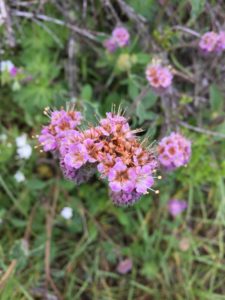
That first day of research was a Friday, so we had a weekend of classes, trip-planning, and cooking up a Thanksgiving dinner in our quincho before we left for a backpacking trip on Monday to finish our work with the guardaparques. Day 2 was an adventure from the very start, as we — already running late — scrambled to catch the stray dog that had been hanging out around camp with the goal of driving it back into town with us (See Fig 6).
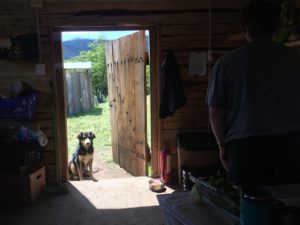
We surveyed various routes on that second day, which left some groups wandering around until close to dinner, but my transect was a fun hike with Kenzie and Memo, an 18-year-old park ranger from Cochrane. My favorite part was eating lunch on a little wooden bridge we found, with our legs dangling over the water, sharing some Oreos that Memo brought. In the afternoon, we kept seeing other groups waving at us from some hill off in the distance — Drew yonder in his red rain jacket, Gabe clambering down a far-off hill in his bucket hat… We camped at an old entrance to the park. Dinner was late because no one soaked the beans, but people went hunting for morels in the trees behind camp, and since someone had driven the cars to camp, we all ate dinner crammed into the trucks, out of the cold, until Sophia leaned back and sat on Team Ñirre’s eggs — whoops. 🙂
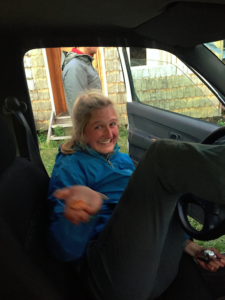
On the third day, our goal was mainly to get backcountry in the park, so we had a nice morning all walking down the trail at our own pace. The Chilean Firebush was one of the many plants blooming everywhere, with burning red flowers, and the backcountry camp we arrived at around noon looked down through Firebush at the huge Lago (Lake) Cochrane below (See Fig 8).
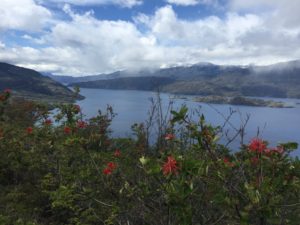
After lunch, we split into small groups to sweep the hill to our west for huemul. This time we weren’t with guardaparques, and Gracie, Adrienne, and I dawdled as we walked, sucking sweet nectar out of the flowers of the Firebush, picking chaura berries, and eating Chilean Sweet Cicely on our way back. We found fresh huemul tracks on a ridgeline at the end of our transect and tried to follow them as Gracie taught us what she’d learned about how to ID male, female, or cría (baby) from the tracks.

Day 4 was our last day working with the guardaparques, who boated across Lago Cochrane to meet us. Unfortunately, in a rush to descend from our camp to start transects for the day, Anna, Gracie, Eliana, and I were split up from the group before we officially started. This may have been a bummer for research or for getting to meet more guardaparques, but really felt like a blessing in every way. Once the four of us had wandered around the base of the mountain for long enough that we were sure we’d lost the group for the morning, we made our own transect along a trail through big old coigües (evergreen trees) along the edge of the lake. We ate lunch on a rocky beach in the sun, and returned to an intersection of trails at the base of the mountain for awhile, napping in the shade and doing work for class, before we hiked back to camp. It was a beautiful day, and entirely different feeling like a tourist rather than a researcher, following all of the trail signs instead of crashing through the scrub.
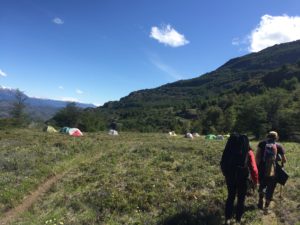
Team Coigüe spent our fifth day hiking out of the park, quizzing each other on plants here and there to get ready for the species quiz that no one had studied for yet. It was a blue-skies day all the way, and I was sad to be finishing our last research trip together. Each of our research trips over the course of our semester have been so different, but every one has really been a gift. When I first started to write this post, I scribbled in my notebook, Three months ago, I was driving to Cochrane with my team having no idea what to expect: no idea what to expect base camp to look like, no idea how I’d fit into our little community here, no idea what places the program might take me… etc.In retrospect, this was kind of hilariously sentimental and irrelevant, but I wrote it because, especially as our program draws to a close, I do feel so lucky to be a part of the work that we d and the fun that we have here. Tamango was one more place not to be forgotten!
